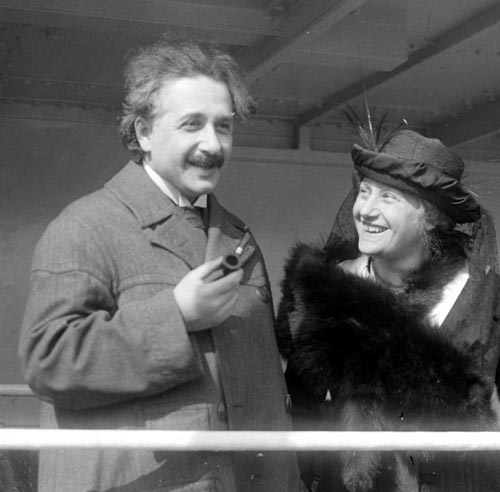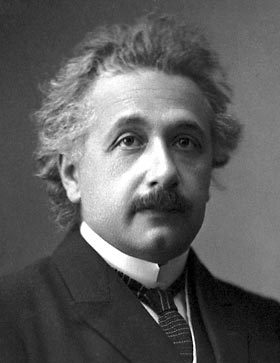Albert Einstein Biography
Albert Einstein Biography
Born in Germany in 1879, Albert Einstein is one of the most celebrated scientists of the Twentieth Century. His theories on relativity laid the framework for a new branch of physics, and Einstein’s E = mc2 on mass-energy equivalence is one of the most famous formulas in the world. In 1921, he was awarded the Nobel Prize in Physics for his contributions to theoretical physics and the evolution of Quantum Theory.
Einstein is also well known as an original free-thinker, speaking on a range of humanitarian and global issues. After contributing to the theoretical development of nuclear physics and encouraging F.D. Roosevelt to start the Manhattan Project, he later spoke out against the use of nuclear weapons.
Born in Germany to Jewish parents, Einstein settled in Switzerland and then, after Hitler’s rise to power, the United States. Einstein was a truly global man and one of the undisputed genius’ of the Twentieth Century.
Early life Albert Einstein
Einstein was born 14 March 1879, in Ulm the German Empire. His parents were working-class (salesman/engineer) and non-observant Jews. Aged 15, the family moved to Milan, Italy, where his father hoped Albert would become a mechanical engineer. However, despite Einstein’s intellect and thirst for knowledge, his early academic reports suggested anything but a glittering career in academia. His teachers found him dim and slow to learn. Part of the problem was that Albert expressed no interest in learning languages and the learning by rote that was popular at the time.
“School failed me, and I failed the school. It bored me. The teachers behaved like Feldwebel (sergeants). I wanted to learn what I wanted to know, but they wanted me to learn for the exam.” Einstein and the Poet (1983)
At the age of 12, Einstein picked up a book on geometry and read it cover to cover. – He would later refer to it as his ‘holy booklet’. He became fascinated by maths and taught himself – becoming acquainted with the great scientific discoveries of the age.

Albert Einstein with wife Elsa
Despite Albert’s independent learning, he languished at school. Eventually, he was asked to leave by the authorities because his indifference was setting a bad example to other students.
He applied for admission to the Federal Institute of Technology in Zurich. His first attempt was a failure because he failed exams in botany, zoology and languages. However, he passed the next year and in 1900 became a Swiss citizen.
At college, he met a fellow student Mileva Maric, and after a long friendship, they married in 1903; they had two sons before divorcing several years later.
In 1896 Einstein renounced his German citizenship to avoid military conscription. For five years he was stateless, before successfully applying for Swiss citizenship in 1901. After graduating from Zurich college, he attempted to gain a teaching post but none was forthcoming; instead, he gained a job in the Swiss Patent Office.
While working at the Patent Office, Einstein continued his own scientific discoveries and began radical experiments to consider the nature of light and space.

Einstein in 1921
He published his first scientific paper in 1900, and by 1905 had completed his PhD entitled “A New Determination of Molecular Dimensions. In addition to working on his PhD, Einstein also worked feverishly on other papers. In 1905, he published four pivotal scientific works, which would revolutionise modern physics. 1905 would later be referred to as his ‘annus mirabilis.’
Einstein’s work started to gain recognition, and he was given a post at the University of Zurich (1909) and, in 1911, was offered the post of full-professor at the Charles-Ferdinand University in Prague (which was then part of Austria-Hungary Empire). He took Austrian-Hungary citizenship to accept the job. In 1914, he returned to Germany and was appointed a director of the Kaiser Wilhelm Institute for Physics. (1914–1932)
Albert Einstein’s Scientific Contributions
Quantum Theory
Einstein suggested that light doesn’t just travel as waves but as electric currents. This photoelectric effect could force metals to release a tiny stream of particles known as ‘quanta’. From this Quantum Theory, other inventors were able to develop devices such as television and movies. He was awarded the Nobel Prize in Physics in 1921.
Special Theory of Relativity
This theory was written in a simple style with no footnotes or academic references. The core of his theory of relativity is that:
“Movement can only be detected and measured as relative movement; the change of position of one body in respect to another.”
Thus there is no fixed absolute standard of comparison for judging the motion of the earth or plants. It was revolutionary because previously people had thought time and distance are absolutes. But, Einstein proved this not to be true.
He also said that if electrons travelled at close to the speed of light, their weight would increase.
This lead to Einstein’s famous equation:
E = mc2
Where E = energy m = mass and c = speed of light.
General Theory of Relativity 1916
Working from a basis of special relativity. Einstein sought to express all physical laws using equations based on mathematical equations.
He devoted the last period of his life trying to formulate a final unified field theory which included a rational explanation for electromagnetism. However, he was to be frustrated in searching for this final breakthrough theory.
Solar eclipse of 1919
In 1911, Einstein predicted the sun’s gravity would bend the light of another star. He based this on his new general theory of relativity. On 29 May 1919, during a solar eclipse, British astronomer and physicist Sir Arthur Eddington was able to confirm Einstein’s prediction. The news was published in newspapers around the world, and it made Einstein internationally known as a leading physicist. It was also symbolic of international co-operation between British and German scientists after the horrors of the First World War.
In the 1920s, Einstein travelled around the world – including the UK, US, Japan, Palestine and other countries. Einstein gave lectures to packed audiences and became an internationally recognised figure for his work on physics, but also his wider observations on world affairs.
Bohr-Einstein debates
During the 1920s, other scientists started developing the work of Einstein and coming to different conclusions on Quantum Physics. In 1925 and 1926, Einstein took part in debates with Max Born about the nature of relativity and quantum physics. Although the two disagreed on physics, they shared a mutual admiration.
Exile
As a German Jew, Einstein was threatened by the rise of the Nazi party. In 1933, when the Nazi’s seized power, they confiscated Einstein’s property, and later started burning his books. Einstein, then in England, took an offer to go to Princeton University in the US. He later wrote that he never had strong opinions about race and nationality but saw himself as a citizen of the world.
“I do not believe in race as such. Race is a fraud. All modern people are the conglomeration of so many ethnic mixtures that no pure race remains.”
Once in the US, Einstein dedicated himself to a strict discipline of academic study. He would spend no time on maintaining his dress and image. He considered these things ‘inessential’ and meant less time for his research. Einstein was notoriously absent-minded. In his youth, he once left his suitcase at a friends house. His friend’s parents told Einstein’s parents: “That young man will never amount to anything, because he can’t remember anything.”
Although a bit of a loner, and happy in his own company, he had a good sense of humour. On January 3, 1943, Einstein received a letter from a girl who was having difficulties with mathematics in her studies. Einstein consoled her when he wrote in reply to her letter
“Do not worry about your difficulties in mathematics. I can assure you that mine are still greater.”
Einstein professed belief in a God “Who reveals himself in the harmony of all being”. But, he followed no established religion. His view of God sought to establish a harmony between science and religion.
“Science without religion is lame, religion without science is blind.”
– Einstein, Science and Religion (1941)
.jpg)
.jpg)

Nice
ReplyDelete👍👍
ReplyDelete